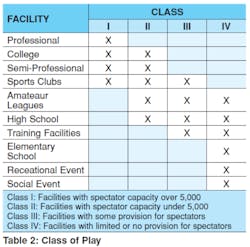IES publishes lighting specification for sports fields and venues
IES RP-6-15 covers recommended lighting practices for recreational to professional sports fields and venues with specific guidelines for individual sports.
The Illuminating Engineering Society of North America (IES) has announced publication of IES RP-6-15 — "Sports and Recreational Area Lighting." The comprehensive Recommended Practice document is focused on lighting specifications for participants and spectators in sports and includes guidelines for a broad variety of activities ranging from croquet to football.
Interested in more articles & announcements on LED lighting specifications & standards?
RP-6-15 is not specific to LED-based solid-state lighting (SSL) installations and includes a discussion of metal halide, fluorescent, LED, and plasma sources. The document notes that LEDs offer an advantage in energy efficiency. And despite the fact that LED-based lighting costs more upfront, the document states that LEDs offer advantages in beam control and less light spill or pollution.
The level of detail in the lighting specification is exactly what specifiers will need to deliver excellent illumination in sports and recreation venues. For example, the document describes lighting specifically for boxing and wrestling and classifies them as ground-based sports. The lighting is more important for spectators and officials than for the participants. The fundamental recommendation for such activities is a definition of horizontal illuminance on a plane near or just above ground level. And the guidelines are broken up by class of venue with those classes defined in the nearby table.
Other sports such as baseball or softball involve balls in the air and are classified in the document as aerial sports. The guidelines define glare zones based on the standard player positions and instruct that light poles are not located in the glare zones to ensure that players can see the ball in the air. Still, the guidelines for lighting are based on horizontal illuminance with the infield having far greater light levels where hard-hit ground balls are fielded.
Some sports are classified as ground-based unidirectional sports such as outdoor archery. The lighting specification document states that horizontal illuminance is most important at the firing line while vertical illuminance is more important at the target line, and therefore the guidelines include separate requirements for each.
The new document provides a detailed section on glare along with tips to minimize glare. The methodologies range from luminaire positioning and aiming to beam selection to treatment of playing surfaces such as glossy basketball courts. The warnings in the document also cover light spill or pollution which can both hamper star gazing and disturb a neighborhood unnecessarily.
The RP-6-15 document does not cover lighting requirements or practices designed to make televised sports look better to the viewer watching at home. In several articles on sports-venue projects, we've noted that one of the project goals was a better TV viewing experience. For example, we covered the LED lighting at the NFL stadium where the Super Bowl was played early this year. Likewise, the Chelsea soccer team from the UK Premier League moved to LED lighting with HDTV being a prime consideration. Specifiers working on such projects will not find the data they need in the new IES document.
The RP-6-15 document is for sale in the IES online store for $75 or for $52.50 to IES members. Another IES document that just recently became available at the store is the LM-80-15 specification for characterizing LEDs. And we recently held a webcast on the new LM-80 standard, which can still be accessed on demand.

Maury Wright | Editor in Chief
Maury Wright is an electronics engineer turned technology journalist, who has focused specifically on the LED & Lighting industry for the past decade. Wright first wrote for LEDs Magazine as a contractor in 2010, and took over as Editor-in-Chief in 2012. He has broad experience in technology areas ranging from microprocessors to digital media to wireless networks that he gained over 30 years in the trade press. Wright has experience running global editorial operations, such as during his tenure as worldwide editorial director of EDN Magazine, and has been instrumental in launching publication websites going back to the earliest days of the Internet. Wright has won numerous industry awards, including multiple ASBPE national awards for B2B journalism excellence, and has received finalist recognition for LEDs Magazine in the FOLIO Eddie Awards. He received a BS in electrical engineering from Auburn University.





